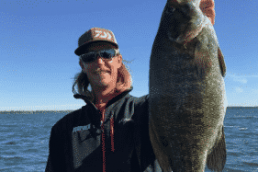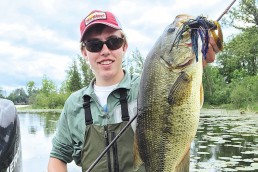Bassmaster AOY Champion Seth Feider Talks Mille Lacs Bass part one
SHARE THIS POST
Tournament young gun Seth Feider may be familiar to MidWest Outdoors TV viewers from past segments he’s hosted on the Mississippi River and on Twin Cities-area lakes. Minnesota bass-tournament anglers certainly know Seth from his many years of local competition.
Feider, 32, is a native of Bloomington, Minn. and began fishing the Bassmaster Elite Series circuit in 2015 after a qualifying season on the “Northern Open” tour in 2014. In 2016, Feider had his best year on the professional tournament trail both in terms of overall finishes and cash winnings. His well-documented “miracle story” came last year with his second-place finish on the Mississippi River in La Crosse that vaulted him into the Angler of the Year Championship on Lake Mille Lacs. Feider ran away with the AOY title, weighing 15 smallmouths over the three-day event for an astonishing 75 pounds, 5 oucnes—a 5-pound average per fish—besting the second-place angler by over 6 pounds in total weight.
MidWest Outdoors recently caught up with Feider while he was en route to the 2017 season’s first Elite event held on Tennessee’s Lake Cherokee. We asked him to discuss the bountiful fishery that is Lake Mille Lacs, one of his home lakes.
MidWest Outdoors: How many years have you been fishing Lake Mille Lacs?
Seth Feider: Actually, the first few times I fished the lake was from shore. My parents have a cabin north of the lake and we used to drive back and forth past it, and my dad would stop near the outlet of the Rum River and let me cast. My first Mille Lacs bass came from there, and I don’t even know how big it was—but it was big! Probably a 4-pounder, but to me it felt like a 10-pounder. I was just a kid.
MWO: Mille Lacs has been a world-class destination for walleye anglers for decades, and traditionally, Minnesota is a walleye-fishing state first and foremost. Smallies have always been viewed as a secondary species in the lake. Talk about the evolution of smallmouths in Mille Lacs and the changes you’ve seen in the fishery over the years.
Feider: My tournament experience has been limited to recent years on the lake simply because regulations have always kept the lake off the radar as a tournament spot (note: for many years, bass harvest on Mille Lacs was limited to one fish over 21 inches, making “weigh” tournaments with limits of bass impossible). So, I was always fishing tournaments on other lakes and didn’t get much time to fish there. But I’ve known how awesome it’s been for years. In my tournament fishing there the past five years I’ve seen it get better and better every year.
MWO: After years of being one of the best-kept secrets to Minnesota bass anglers, the reputation is spreading. It’s great to see the publicity that Mille Lacs is getting nationally now, isn’t it?
Are you enjoying this post?
You can be among the first to get the latest info on where to go, what to use and how to use it!
Feider: It is good for the area. (But) is the bass fishing going to continue to get better? I don’t know that. Everything’s got to peak at some point, right? The lake’s going to see a lot more pressure and those fish are going to get harder to catch. I don’t think they’ll be as “dumb” as they used to be. At the end of the day, hands down I still believe it to be the best smallmouth lake in the country.
MWO: What’s so impressive about Lake Mille Lacs bass?
Feider: First of all, the numbers of really big fish. Lots of places across the country kick out 5-pounders, but the sheer number of them in Mille Lacs is second to none. I’ve had days in the fall catching 50 fish over 5 pounds in a day plus a few over 6 mixed in—it’s just unreal.
MWO: There’s a recent MNDNR regulation change that permits a catch-and-release bass season in the southern two-thirds of the state starting with the Minnesota Fishing Opener—for walleyes and northern pike—in mid-May. Then, when the bass season fully opens on May 27, some bass of “certain lengths” can be kept by anglers if they so choose. In your mind, how important is it to protect the bass fishery on Lake Mille Lacs?
Feider: Oh, it’s huge—absolutely crucial. And that’s one thing we’re going to have to stress. The lake is going to get a lot more travelers, a lot of fishermen. People might want to keep one of those giant trophies. The problem is, living this far north, a lot of those fish are really, really old. They take a long time to grow in cold water. It’s not like down south where a fish gets to 5 pounds really quick. A big Mille Lacs smallie might be 15 to 20 years old. If you start wiping those fish out you’re going to ruin the fishery pretty fast. So, catch and release on the giants is crucial; it’s what’s made the fishery what it is today—the best smallmouth bass lake in the country, releasing bass back into the lake for the better part of 20 years. But if people want to keep a few of the smaller ones for a meal, that’s their choice.
MWO: There are plenty of walleyes in the lake to eat. Talk about the other species the lake offers. Lake Mille Lacs truly is a “Fantastic Four” fishery.
Feider: It’s an unbelievable lake for almost any species. Pretty much every single time I’m on the lake bass fishing I catch about 15 walleyes and I’m not even targeting them. People say the walleye numbers are just “fair,” but if I’m catching 15 of ‘em there must be a few swimming around. I can’t speak to how good the walleyes were in the lake 20 years ago, but I guess it was absolutely insane for numbers back in the day.
MWO: Historically, the lake bounces back quickly from cyclical dips in the walleye population. The 2013 year-class is huge; there are excellent numbers of those fish in the system that are now between 15-18 inches. Plus, a lot of larger walleyes swim in Lake Mille Lacs. In winter and then into early spring, catches of big walleyes measuring 25 inches or more were way above average. Speaking of big fish, how about the big toothy predators?
Feider: There are giant northern pike in Mille Lacs, and the next state-record muskie is swimming in there, too. There are pictures of those fish circulating out there. I’ve personally never caught a muskie on the lake, but I’m not fishing for them. I know the guys who do catch some real giant ones. A funny thing is how overlooked the largemouths are. The smallies get so much attention they (largemouths) are kind of a forgotten fish. But there are huge largemouths in the weeds and under the docks in the back bays—nobody fishes for them. And one time I was at an access and a couple of old-timers in a beat up tin boat were coming off the lake and had two stringers of 2-pound crappies. Some were 16 inches. I was astonished!
MWO
SHARE THIS POST
Did you enjoy this post?
You can be among the first to get the latest info on where to go, what to use and how to use it!


